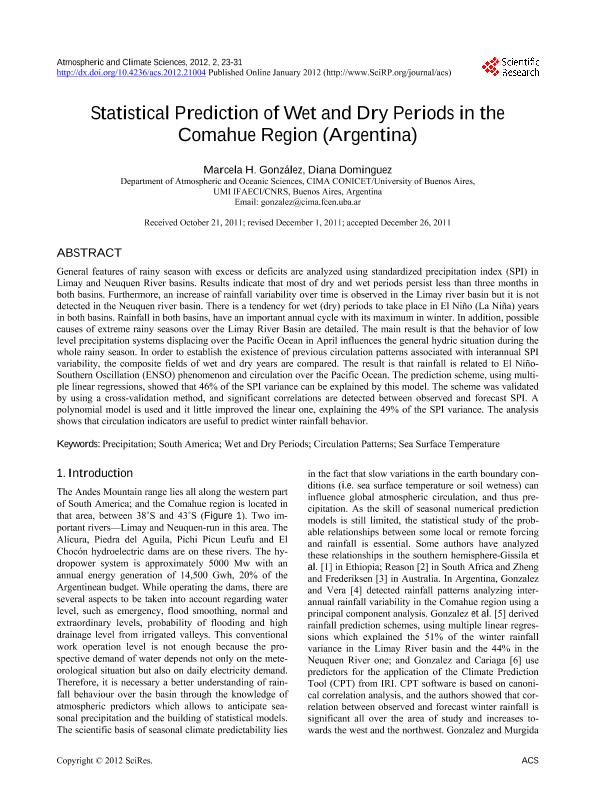Artículo
Statistical Prediction of wet and dry periods in the Comahue Region (Argentina)
Fecha de publicación:
01/2012
Editorial:
Scientific Research
Revista:
Atmospheric and Climate Sciences
ISSN:
2160-0414
Idioma:
Inglés
Tipo de recurso:
Artículo publicado
Clasificación temática:
Resumen
General features of rainy season with excess or deficits are analyzed using standardized precipitation index (SPI) in Limay and Neuquen River basins. Results indicate that most of dry and wet periods persist less than three months in both basins. Furthermore, an increase of rainfall variability over time is observed in the Limay river basin but it is not detected in the Neuquen river basin. There is a tendency for wet (dry) periods to take place in El Niño (La Niña) years in both basins. Rainfall in both basins, have an important annual cycle with its maximum in winter. In addition, possible causes of extreme rainy seasons over the Limay River Basin are detailed. The main result is that the behavior of low level precipitation systems displacing over the Pacific Ocean in April influences the general hydric situation during the whole rainy season. In order to establish the existence of previous circulation patterns associated with interannual SPI variability, the composite fields of wet and dry years are compared. The result is that rainfall is related to El Niño- Southern Oscillation (ENSO) phenomenon and circulation over the Pacific Ocean. The prediction scheme, using multiple linear regressions, showed that 46% of the SPI variance can be explained by this model. The scheme was validated by using a cross-validation method, and significant correlations are detected between observed and forecast SPI. A polynomial model is used and it little improved the linear one, explaining the 49% of the SPI variance. The analysis shows that circulation indicators are useful to predict winter rainfall behavior.
Archivos asociados
Licencia
Identificadores
Colecciones
Articulos(CIMA)
Articulos de CENTRO DE INVESTIGACIONES DEL MAR Y LA ATMOSFERA
Articulos de CENTRO DE INVESTIGACIONES DEL MAR Y LA ATMOSFERA
Citación
González, Marcela Hebe; Domínguez, Diana; Statistical Prediction of wet and dry periods in the Comahue Region (Argentina); Scientific Research; Atmospheric and Climate Sciences; 2; 1; 1-2012; 23-31
Compartir
Altmétricas




